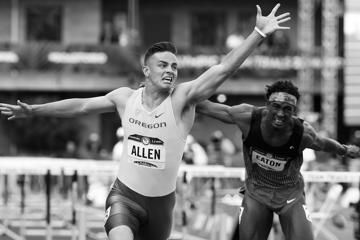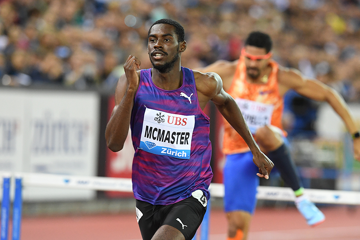Jasmine Camacho-Quinn at the 2016 Olympics (© Getty)
One little mistake in Rio led to months of heartache for Jasmine Camacho-Quinn, but the 21-year-old Puerto Rican has come out stronger on the other side, and she’s started her 2018 outdoor campaign as the fastest hurdler in the world.
It’s the story seldom told.
In a world obsessed with winners, what happens to those athletes who quietly slip away when the medals are handed out, the men and women whose private tears are tinged with the repulsive taste of regret?
Jasmine Camacho-Quinn thinks back to a race she’d rather forget, the Olympic 100m hurdles semi-final in 2016. She was 19 at the time, a wide-eyed teenager at her first Games, and after powering over seven of the 10 barriers she was on the brink of making the final.
At that point she’d been hurdling for six years, and not once had she come to grief in a race.
“It was just one little mistake,” she says. “It ended badly.”
Her trail leg clipped the top of the eighth barrier, enough to shift her momentum forward as she approached the ninth. Try as she might, at that speed she just couldn’t hoist her lead leg up in time and that was it – Camacho-Quinn clattered it, stumbled and barrelled straight through the 10th hurdle. Game over.
In those moments, time stood still, Camacho-Quinn collapsing to her knees after the finish. But through a torrent of tears in her post-race interview, she made a promise: “I’m not going to let this race determine my future.”
For a long time, however, it did.
Hard Times
In the weeks after she returned to college at the University of Kentucky but the effect of the race still lingered.
“It honestly took me the whole semester of school. I didn’t want to be on campus. I didn’t want to be around nobody because I’d rather that happen at a little meet than at the Olympics, I knew I had to wait four more years.
“I felt embarrassed, like I let the whole country down, but I also received a lot of love. Everybody was so supportive and proud of me for making it, being so young and getting out there representing Puerto Rico.”
Camacho-Quinn threw herself into winter training with a fresh resolve, but though her mind was willing her body was crying surrender.
“I came back too quick,” she says. “I was really tired still so I wasn’t doing everything correctly. I gained a lot of weight and I started dealing with injuries and stuff like that. I was exhausted and tired and still upset with how everything played out.”
The previous year Camacho-Quinn had announced herself as a rare talent, becoming the first freshman in history to win the NCAA 100m hurdles title, clocking 12.54, but 2017 saw her battle injuries in her hip flexor, knee and SI joints and she was always fighting an uphill battle.
She nonetheless finished second in the NCAA Championships in 12.58 but after that she told her coach she was done for the summer, turning down a medal chance at the IAAF World Championships in London.
“I knew I needed to take time off and rest,” says Camacho-Quinn, who dropped more than 10 pounds over the summer.
“I lost the weight in a month or two and it wasn’t purposely done, just by taking a break and letting my body rest. I just wanted to live a regular life for the summer so I did that and it turned out for the best.”
Flying Start
She hit the ground running in 2018, clocking a national record of 7.95 for 60m hurdles indoors then equalling her Puerto Rican record of 12.58 in a heat at the SEC Championships in Knoxville, Tennessee mid-May. After that race her training partner in Kentucky, world record holder Keni Harrison, texted a friend with a prediction for the final: “Quinn should run 12.4.”
And that’s exactly what she did, Camacho-Quinn obliterating her rivals over the latter half of the race to smash her Puerto Rican record with a world-leading 12.40.
It was the best race of her career by some distance, but given the wind wasn’t overly strong (1.2m/s) and she’s still only 21, the question now is how much quicker she can go?
“I still have room to improve,” she says. “I reacted well but not correctly, meaning I popped straight up out of the blocks. If I reacted correctly then it would have been much better.”
If that sounds like perfectionism at play, it’s worth noting where Camacho-Quinn is based – at the University of Kentucky in Lexington, where a horde of the world’s best athletes train under the watchful eye of hurdles guru Edrick Floreal.
“He is really honest with his hurdlers and he’s very technical,” says Camacho-Quinn. “We could be at practice for a long, long, long time. He wants everything to be done correctly so when we go out in a race we can do what we did in practice. He takes his time and is very patient.”
Olympic 110m hurdles champion Omar McLeod, world 400m hurdles champion Kori Carter and world U20 400m hurdles record holder Sydney McLaughlin are all part of the group, though the athlete Camacho-Quinn works out with most is Harrison, the world record holder in their event.
“Nobody really likes to practise,” she admits. “But with Edrick being able to point out everything it helps us. Whatever he says, go and fix it and you’ll see the outcome in the race.”
It was Floreal who recruited Camacho-Quinn in high school, back when the South Carolina native was drawing attention from coaches across the country as she racked up state titles in sprints, hurdles and even long jump.
“He was really loyal from the beginning, he kept in contact and challenged me,” she says. “I believed everything he was saying about the programme he built.”
Genetic Gift
It may come as no surprise to learn that Camacho-Quinn comes from good athletic stock. Her parents met at Charleston Southern University (formerly Baptist College), where they were both track scholarship students, and older brother Robert is an American football star who plays defensive end for the Miami Dolphins.
Her dad, James, coached her throughout her teenage years, and when Camacho-Quinn first tried hurdles in eighth grade she quickly established herself among the fastest in the country for her age. Throughout her childhood she had been a high-level gymnast though she turned her back on that after sustaining injuries in eighth grade.
If Camacho-Quinn seems an unusual surname, that’s because her dad is a South Carolina native while her mom, Maria, is from Puerto Rico, which gave Camacho-Quinn a choice about who to represent internationally.
In 2016, on the countdown to the Rio Olympics, she opted for Puerto Rico and plans to stick with them for rest of her career. “My mom was really excited,” she says. “She wanted me to run for Puerto Rico because she never got to do it when she was younger. I wear it with pride.”
Later this year she’ll be donning the red, white and blue – of Puerto Rico, that is – for the North American, Central American and Caribbean [NACAC] Championships in Toronto, though first up there’s the matter of reclaiming her NCAA title in Eugene, Oregon next month.
This week, Camacho-Quinn will be back on the start line for the NCAA East Preliminary Championships in Tampa, Florida, where she believes she might just be ready to join the illustrious 12.3 club. But no matter what the summer holds, Camacho-Quinn will be back in Kentucky this autumn, where she will be entering her senior year studying community and leadership development.
“I didn’t want the responsibilities of being an adult at 19,” she says. “Being on a scholarship, I might as well finish school and have it paid for. I wasn’t in any rush so I felt as if I needed to stay and get better.”
And now, at 21 – still barely old enough to have a legal drink where she lives – Camacho-Quinn finds herself as the fastest hurdler in the world, yet also, curiously, the second fastest in her training group.
She’s got all the time in the world, but is nonetheless in a rush to the top.
Words: Cathal Dennehy
Photography: Getty/University of Kentucky







